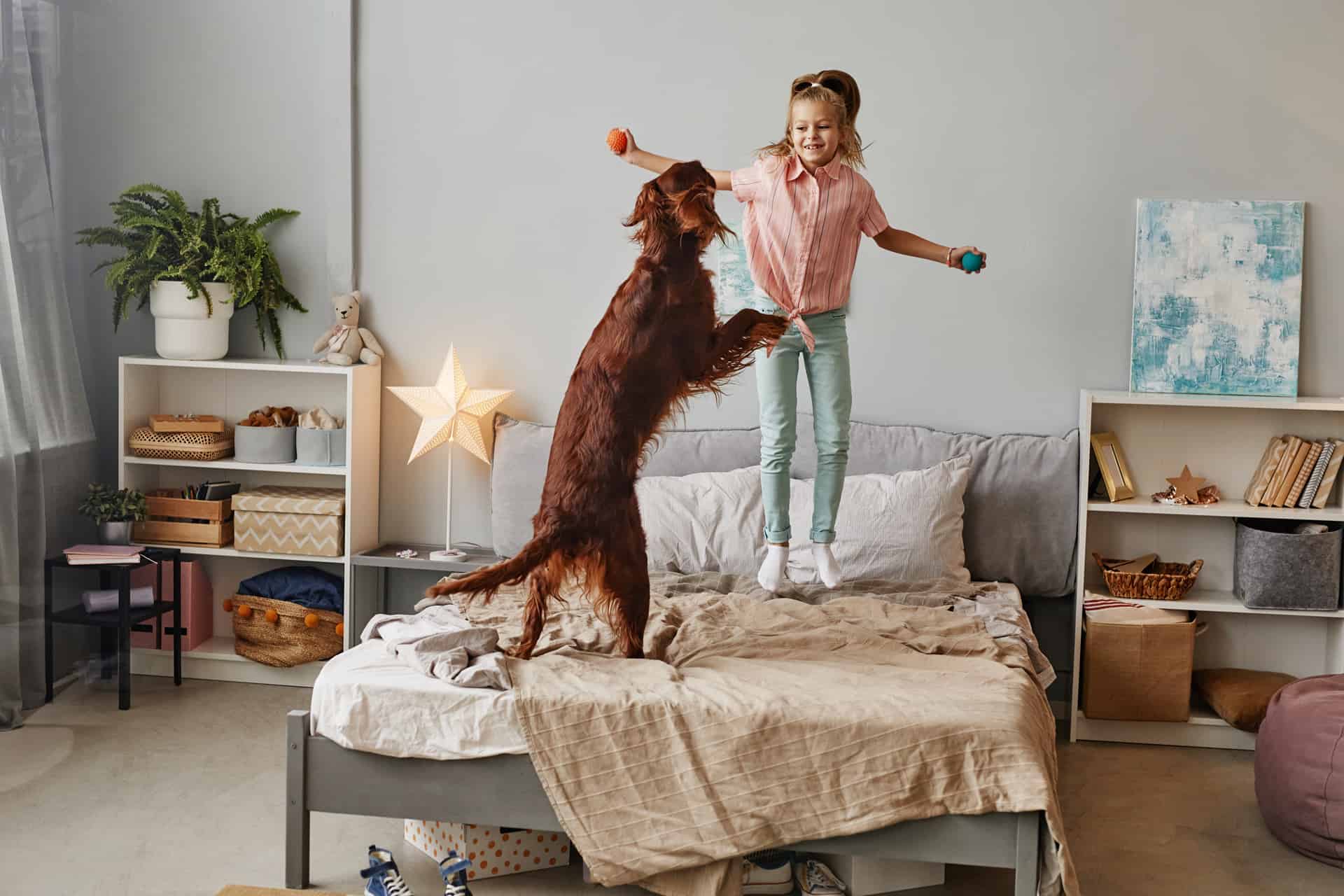Pros of Allowing Your Dog on Furniture
Permitting your pup on your furniture is not only a great way to snuggle and bond, but it also has other benefits. This lets them understand they can share the same space as you, telling them they are loved and accepted.
Let’s check out the advantages of letting your doggo onto your furniture!
Bonding and Comfort
Having your pooch on furniture can be a great way to build closeness and coziness between you and your furry mate. Here are some benefits of it:
- Bonding: This can increase bonding time between you and your pet. Cuddling and snuggling on the couch is a great way to get closer to your pup.
- Comfort: Dogs enjoy being comfy and furniture offers them a nice spot to rest and relax. Especially elderly or dogs in joint pain, accessing furniture may be difficult; hence, comfort should be a priority.
Nevertheless, it’s essential to consider some drawbacks too, like hygiene and cleanliness, as well as ensuring your dog does not view himself as the leader of the house, as this may lead to future behavioural problems.
Pro Tip: If you choose to let them on furniture, start by setting some rules, such as not allowing them on certain pieces or only after receiving permission.
Temperature Regulation for Older Dogs
As canines age, their body’s ability to stay at a steady temperature weakens. This makes them more prone to extreme temperatures. Here are ways to help keep their temperature regulated:
- Utilize insulated doghouses or heated beds for a cozy sleeping environment during cold weather.
- Ensure your pup has plenty of shade and access to cool water during hot weather to stop over-heating.
- Don’t exercise your pup during the hottest parts of the day in summer.
- Use cooling mats, bandanas, or vests to regulate their body temperature.
When it comes to allowing your pup onto furniture, there are positives, like increasing the bond between you and your pet. But also negatives, like the possibility of injury from jumping or accidents. Consider their age, size, behaviour, and your own inclinations and lifestyle when allowing your pup on furniture.
Pro Tip: Talk to your vet to decide on the best temperature regulation techniques for your older pup.
Aesthetic Appeal
Allowing your pup on furniture can add style to your house, as well as other advantages.
Pros of Letting Your Dog on Furniture:
- Comfort – Dogs like soft surfaces like beds and sofas, which can help them relax.
- Connecting – Letting your dog cuddle with you on the furniture is a great way to be closer and make your relationship stronger.
- Heat – Dogs, especially small ones and those with short fur, can feel cold sleeping on the ground. Letting them on furniture keeps them warm.
- Safety – Dogs love being close to their owners to feel safe and secure. They often choose to sleep on their owner’s bed or sofa when the family is around.
When to Think About Letting Your Dog on Furniture:
Although allowing your pup on furniture has its benefits, it can also be tricky. Consider your dog’s size, age, character, and house setup before doing this.
Pro tip: Cover furniture with washable blankets or throws to protect furniture and make cleaning up easier.
Cons of Allowing Your Dog on Furniture
A tricky choice to make is letting your pup on the furniture. Before deciding, lots of things should be thought about. Here, we’ll go over the possible downfalls of allowing your canine on the furniture.
House Training Challenges
Letting your pup on the furniture can be tricky when house training them. Consider the pros and cons before making any decisions.
Cons:
- Upholstered furniture can easily get dirty or damaged with pet hair, scratches, or accidents.
- Dogs on furniture might act territorial and become aggressive.
Pros:
- It can strengthen the bond between you and your pup.
- It gives warmth and comfort to both of you.
If you choose to let your pup on furniture, set boundary rules from the beginning. Also give them a comfy bed to discourage bad behavior.
Potential for Aggression
Allowing your pup on furniture may have its drawbacks. They might become possessive and territorial of their ‘throne’. Dogs that aren’t used to furniture may become anxious and aggressive when guests come over. Also, when removed from their cozy spot, they may become aggressive.
Instead of letting them on furniture, give them their own bed or crate. Train them to be comfortable there. Pro tip: A well-trained dog is a happy dog and keeping furniture pet-free can save you from aggression issues.
Health Risks for Some Breeds
Letting your furry friend on the furniture can be fun. But, some breeds have health risks. Spinal, neck or hip issues can be made worse by sitting positions on elevated furniture. Breeds at risk include Dachshunds, Basset Hounds, Corgis, Bulldogs, Greyhounds, Pugs and Miniature Schnauzers.
Unless your pet shows any signs of discomfort, aggression, or disobedience, you can let them on the bed or couch. But, keep it clean and hygienic.
Pro Tip: Have a spot for your pet to lounge or rest, like a dog bed or sofa, to stop them from jumping on furniture unsupervised.
Factors to Consider Before Allowing Your Dog on Furniture
Before letting your pup on the furniture, you should think about a few elements. These are the size of your pooch, your personal preferences, and potential dangers. Weighing up the good and bad points will help you to make a wise call on when to let your dog jump on the furniture. Let’s explore this more.
Size and Breed of Your Dog
Considering the size and breed of your pup is key before letting them on your furniture. Is your pup small? If so, less damage is likely to be done. But if it’s a big breed, like a Great Dane, their weight could cause major damage. Some breeds shed a lot or have long claws, which could also be destructive. Weigh the pros and cons before letting them up. Bonding is great, but it could end with bad behavior and damaged furniture.
Pro Tip: Invest in a good quality dog bed or furniture cover to protect your furniture.
Pre-existing Health Conditions
If you have a pup with pre-existing health issues, extra precaution is needed before letting them climb or jump onto your furniture. Consider these factors for their comfort and safety:
- Pain: If your dog is in pain or has joint/hip conditions, climbing furniture could worsen it.
- Age: Older dogs may have difficulty jumping or climbing, risking injuries or pain.
- Breed: Bulldogs and Corgis may struggle due to size and body shape.
- Health: Pugs may have trouble breathing on a sofa or other soft surfaces.
- Know your pup’s specific needs to make an informed decision. If you do let them on furniture, provide support and a comfy space to prevent any harm.
Your Lifestyle and Preferences
Allow your pup on furniture? It’s up to you! Pros and cons exist. Here are some factors to think about:
- Your dog’s size and temperament.
- The type of furniture you have.
- The cleanliness of your home.
- Your attachment to furniture.
- Your comfort and preference.
By considering these, you can make an informed choice. There’s no right or wrong answer. It’s all about what works best for you and your lifestyle.
How to Train Your Dog to Stay off Furniture
You and your pup can benefit or be harmed by your dog being on furniture. The breed of your pup, their size, activity level, and other factors must be considered. Although your pet may enjoy the comfort of furniture, there are challenges.
Let’s look at the pros and cons of furniture access for your pup:
Use Positive Reinforcement
Positive reinforcement is a powerful way to train your pup. Instead of punishing them for jumping up on the couch, reward them each time they obey your commands! Here’s how:
- Make clear rules and stick to them. Remain consistent and stay firm.
- Provide your pup with a comfy dog bed or crate as an alternative.
- Use treats, praise, and toys as rewards for good behavior, like staying on their bed or walking away from furniture.
- Put up physical barriers such as baby gates or closed doors to avoid unwanted access.
By using positive reinforcement, you can effectively teach your pup to stay off furniture. Think about the pros and cons of allowing them on the furniture and decide what works best for you both.
Pro tip: Positive reinforcement isn’t just great for training dogs. It can be used in other areas of life too, for better results and a happier mindset.
Create a Designated Space for Your Dog
Designing a spot for your pup is essential for keeping your house orderly and teaching your pet to stay off furniture. Here’s how to make a specific area for your furry mate:
- Pick a chosen area in your home that’s cozy, ample, and far from high-traffic areas like the entry door or the kitchen.
- Fill the space with comfy bedding, chew toys, and water and food bowls.
- Train your pup to combine the particular area with positive experiences by applauding and rewarding it when it stays in the region.
- Regularity is necessary – ensure you train your dog to stay off furniture from the start so it doesn’t become a practice.
- Lastly, if you do permit your dog on furniture, guarantee to set up precise confines and observe a consistent training routine.
Pro tip: Purchase a great pet gate to keep your pup in its particular area and away from rooms or furniture you don’t want it to access.
Be Persistent and Consistent with Training
Train your pup to stay off the furniture with persistence and consistency. Set up clear rules and enforce them to make your pup understand what’s expected. Here are a few steps:
- Choose an area where your pup can rest or sleep.
- Use positive reinforcement like treats, toys, or praise when your pup listens and follows commands.
- Be consistent with a command like “off” or “down” to keep your pup off the furniture.
- If your pup attempts to climb on the furniture, redirect their attention with a treat or toy.
- If your pup is still struggling, try a deterrent like a spray bottle or couch cover.
Pro tip: Reward your pup when they stay in their designated area. This will help them understand where they should rest and lessen the urge to climb on the furniture.
Alternatives to Allowing Your Dog on Furniture
Want to let your pup on furniture, but not sure what to do? There’re different options. We’ll look at the pros and cons.
- You could cover your furniture with special fabric.
- Or get your dog a comfy bed.
No need to say a hard no-go!
Dog Beds and Blankets
Dog beds and blankets are a great option instead of letting your pooch on the furniture. But, sometimes you may need to let them on the furniture, and that has its own advantages and disadvantages.
Alternatives: Dog beds and blankets can be comfy and secure for your pup to snuggle and chill without messing up your furniture or making your living room look untidy. These come in many sizes, shapes, and materials for all types of dogs.
Pros: Allowing your doggie on the furniture helps build a stronger bond between you two. It also gives them a sense of security and comfort when they’re chilling next to you. It can also be useful for dogs with mobility or arthritis issues.
Cons: Having your pup on the furniture can cause health and hygiene problems. For example, dirt, dander, and bacteria can gather on your furniture and cause allergies or other issues. It also presents a challenge when it comes to cleaning, and your furniture may get damaged.
Think carefully before letting your pup on the furniture. It may make them feel comfy, but there are hygiene concerns.
Pro Tip – Use pet-friendly materials or throws to cover your furniture that are easy to clean and stay clean.
Designated Play Areas
Designated play areas are a great way to keep your pup off the furniture. Not only does this preserve your furniture from scratches and dirt, but it also gives your doggo a safe spot to play and exercise. Here are some tips for setting up one:
- Choose an area in your home that’s spacious, safe and easy to clean.
- Use pet-friendly and non-toxic materials like rubber mats and turf to cover the floor.
- Throw in some toys, chews and puzzles to keep your pup entertained.
- Think about adding an obstacle course or agility equipment for physical and mental stimulation.
When it comes to letting your pup on the furniture, there are pros and cons to consider. It can be comfortable and cozy for both of you but it can be hard to train and lead to behavioral issues. Ultimately, the choice is up to you and your lifestyle.
Outdoor Playtime and Exercise
Outdoor play and exercise are essential for your pup’s wellbeing. Instead of letting your dog jump on furniture, here are some great alternatives.
- Take your pooch on a daily jog or stroll to get their blood flowing. Depending on breed and age, playtime could vary from thirty minutes to several hours a day.
- Play catch or frisbee with your pup in the park or backyard. This will keep them entertained and help them expend energy.
- Set up obstacle courses using objects such as cones, hula hoops, and jumps to challenge their agility and coordination.
- Enroll your dog in obedience or agility classes to give them physical and mental stimulation.
- Weigh up the pros and cons of allowing your dog on furniture. While it may provide comfort and closeness, it can lead to behavior and hygiene issues. Ultimately, the choice is up to you as the pet owner.
Frequently Asked Questions
1. Should I allow my dog on furniture?
It depends on your personal preference and lifestyle. Allowing your dog on furniture can create a strong bond between you and your pet, but it can also lead to behavioral issues and increased cleaning needs.
2. What are the pros of allowing my dog on furniture?
Allowing your dog on furniture can strengthen the bond between you and your pet and provide a cozy and comfortable spot for them to rest. It can also increase socialization and help them feel like a valued member of the family.
3. What are the cons of allowing my dog on furniture?
Allowing your dog on furniture can lead to behavioral issues such as resource guarding and separation anxiety, and can also increase cleaning needs as pet hair and dander can accumulate on furniture.
4. Can allowing my dog on furniture affect their behavior?
Yes, allowing your dog on furniture can lead to behavioral issues such as resource guarding and separation anxiety. It can also reinforce bad habits such as begging for food or attention.
5. How can I train my dog to stay off furniture?
Consistent training and positive reinforcement can be effective in training your dog to stay off furniture. Providing a designated spot for them to rest and rewarding them for using it can also be helpful.
6. Can I allow my dog on some furniture and not others?
Yes, you can allow your dog on some furniture and not others. It is important to establish consistent rules and boundaries to prevent confusion and any potential behavioral issues.







